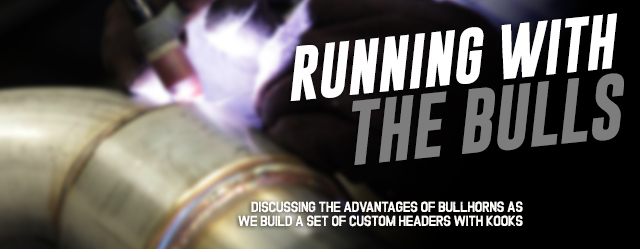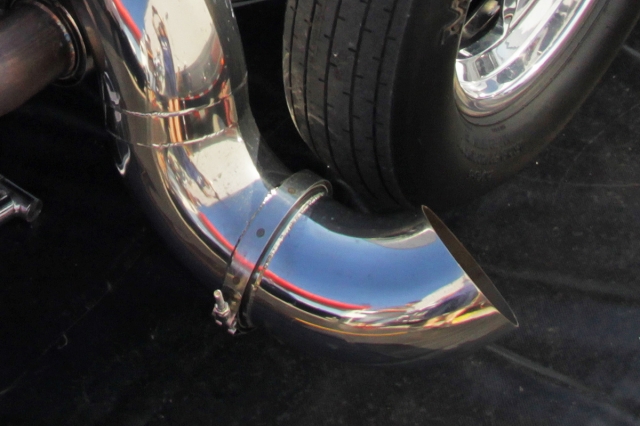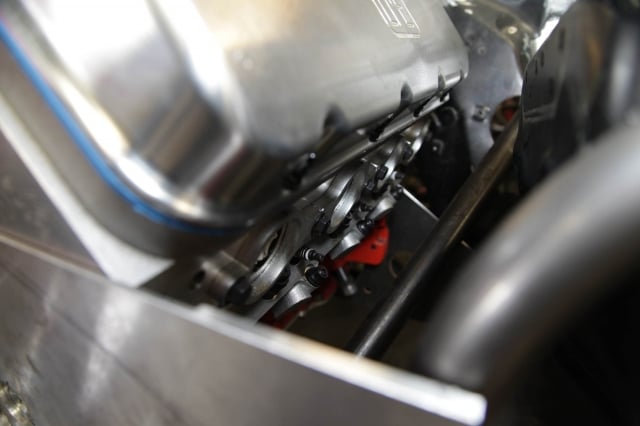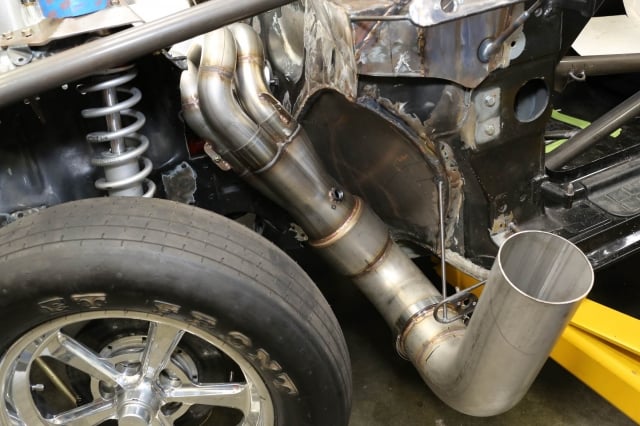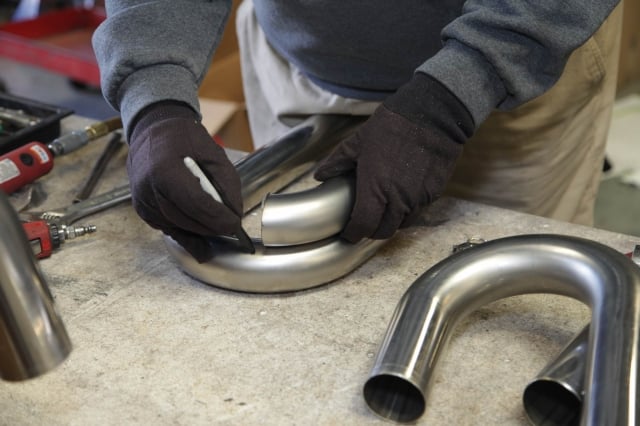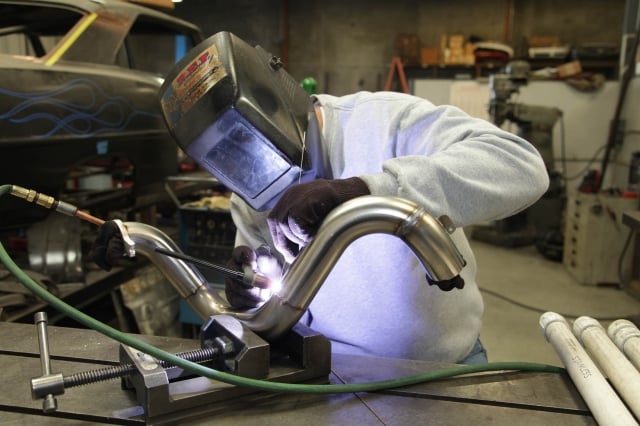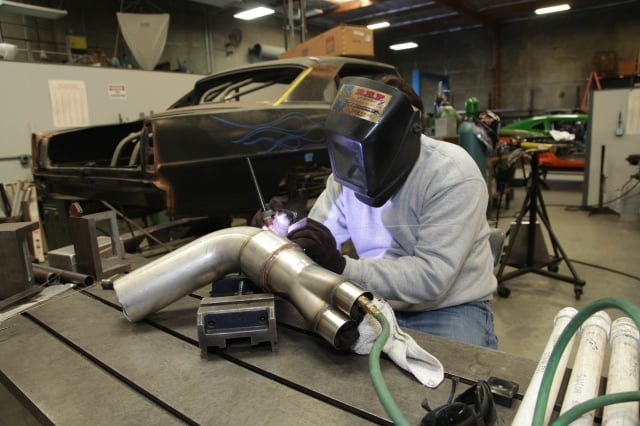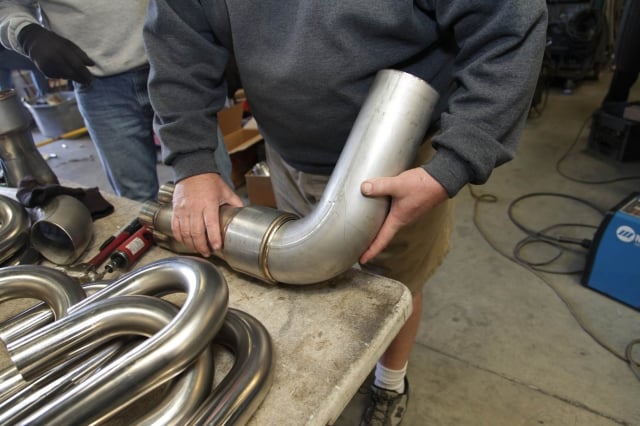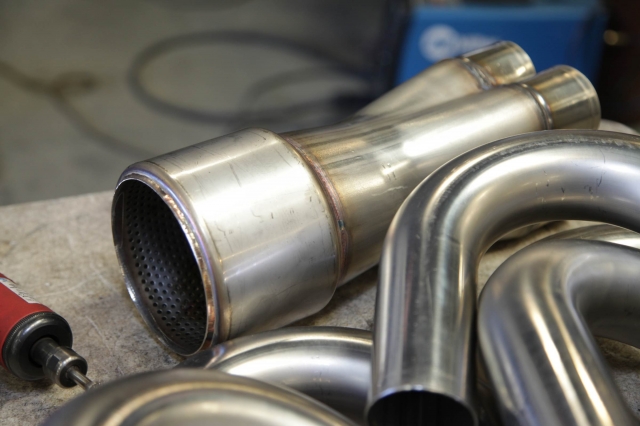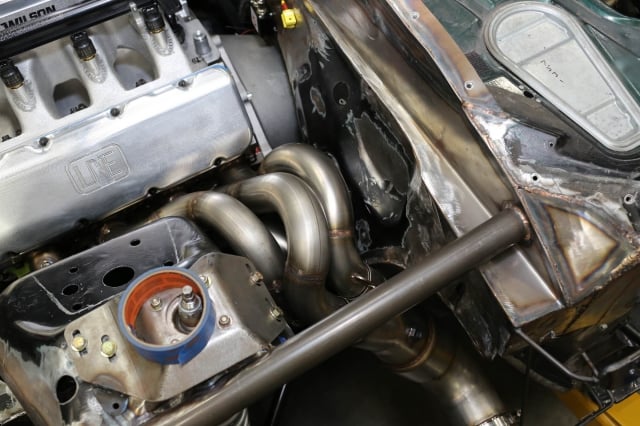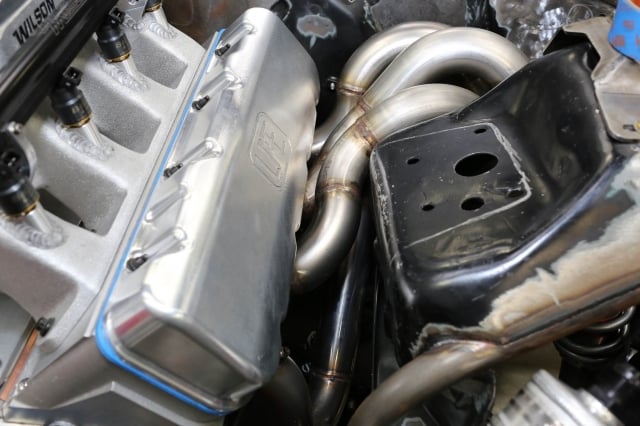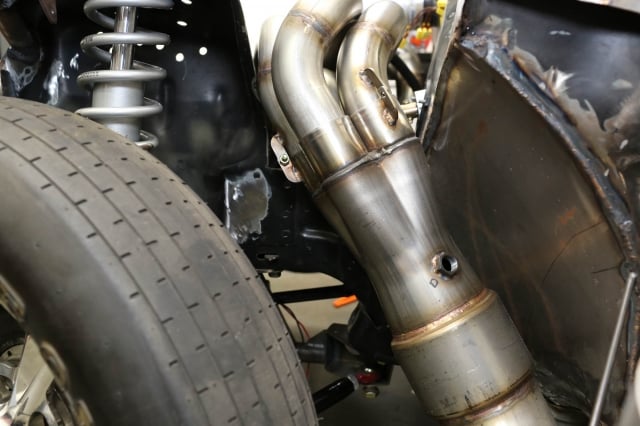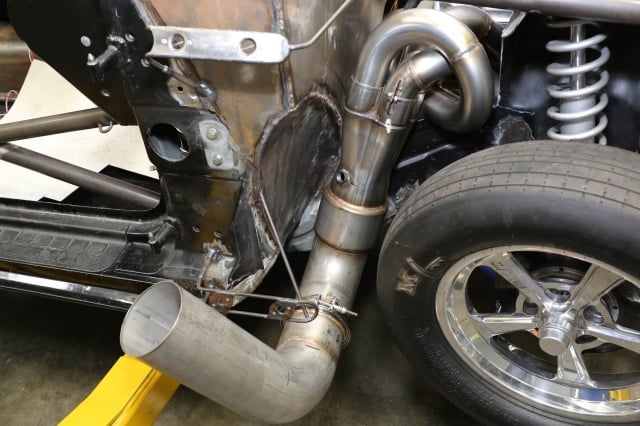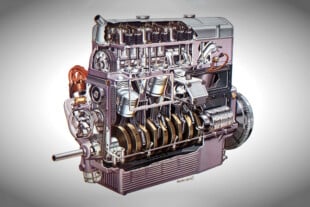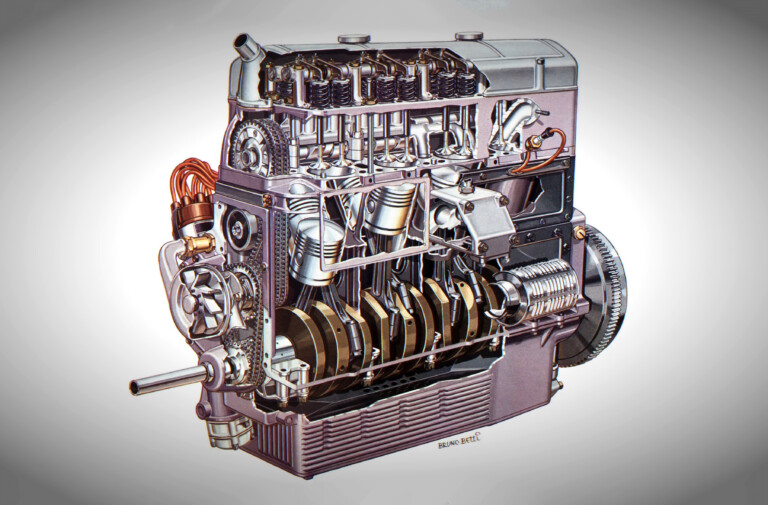Love ‘em or hate ‘em, “bullhorns” are here to stay in drag racing.
You know what we’re talking about — the large-diameter exhaust exits found on many small-tire outlaw cars that look like, the horns on a bull, that range in size, length, and angle, but all aim to accomplish the same result. You see, these pipes aren’t just there for looks or other non-performance means; they do in fact have a very real purpose, and as many have found — and the reason they’ve become so popular — they deliver very real results.
Our goal with this text is to illustrate these results, as we work together with the folks at Kooks Custom Headers to develop a new set of headers and bullhorns for our Project BlownZ 275 radial tire Camaro for the season ahead. Before we get to that, though, let’s take a look at at the ‘what’ and ‘why’ of bullhorns, and how the exhaust manufacturers and engine builders determine the size, shape, and layout of an exhaust system for drag racing vehicles.
Take one good look at the typical set of bullhorns and you can probably figure out how racers are using them to their advantage.
The answer? Thrust.
Just like a modern airplane uses jet propulsion to pass air in the opposite direction to that of its intended direction of motion, so too do the bullhorns on a race car — albeit on a much smaller scale, mind you. By directing the fast-moving exhaust gases coming from the combustion chamber out into the atmosphere at an upward angle, a degree of downward thrust is created that, although largely unmeasurable, helps to keep the front end on the ground on temperamental doorslammers that, in many cases, aren’t equipped with wheelie bars.
What racers are continuing to test, and what they’re saying, is that the bullhorns are acting as a propulsion system in a way, and it’s helping them get downforce on the nose of the car. – Chris Clark
“What racers are continuing to test, and what they’re saying, is that the bullhorns are acting as a propulsion system in a way, and it’s helping them get downforce on the nose of the car,” says Kooks’ Chris Clark. “We haven’t tested the theories on an in-house car, but we’ve gotten great feedback from the majority of our racers.
“They don’t want them turned up too high, and certainly they don’t want them burning the body either” continued Clark, “so it’s some testing to get them right.”
Racers have played with a number of different sizes, angles, and even positions on the race car, all in an effort to produce additional thrust and determine how and where it works best.
“The bullhorns have been different for everybody. Some racers don’t require them, and others have played with the angles. What we’ve done for the racers that’s different from a slip-joint type setup or similar is to set the collector and bullhorn up where they can twist the v-bend at different angles on the car,” explains Clark.
Clark went on to explain, “There’s not really any any science behind it, and a lot of it depends on the power adder combination that a racer is using. Blower racers want the exhaust out as quick as possible, and most of them still prefer the ‘zoomie’ header. Nitrous cars tend to work better with the 4-into-1 with a merge collector.”
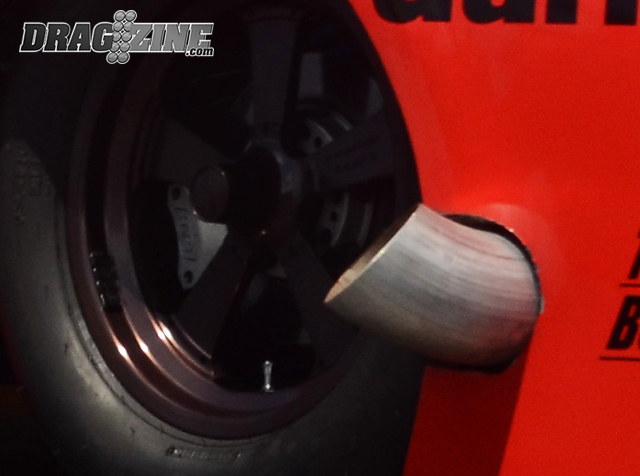
In addition to pipe and collector sizing and bullhorn angles, the locations can also differ, from fore and aft of the front wheels, high up in the fender or down low along the ground.
Sizes, Lengths, And Shapes, Oh My: What Do You Need?
Matching an engine and drivetrain combination with just the right set of custom headers, from the appropriate diameter of the header primaries, to the size, length, and shape of the collector, can seem like a black art, and truth be told, there is a very specific science to it all. There are enough variables involved to make the average person’s head spin. Fortunately, the staff at Kooks and any good engine builder worth commissioning have a pretty good handle on it.
“All of the knowledge that we’ve built over the last 50-plus years of involvement in all forms of racing has given us a level of experience to pinpoint header diameters, header lengths, collector size, lengths of the merges, and all of those things,” says Clark. “We do, however, take the word of the engine builders when working direct with them, because they’re the one spec’ing the camshafts, the exhaust valves, cylinder heads, and all of those variables that come into play.”
As Clark tells us, the first thing that the Kooks staff does is lay out a set of questions that help provide a foundation of sorts, and this begins by determining if the car is going to run the 1/8 or 1/4-mile.
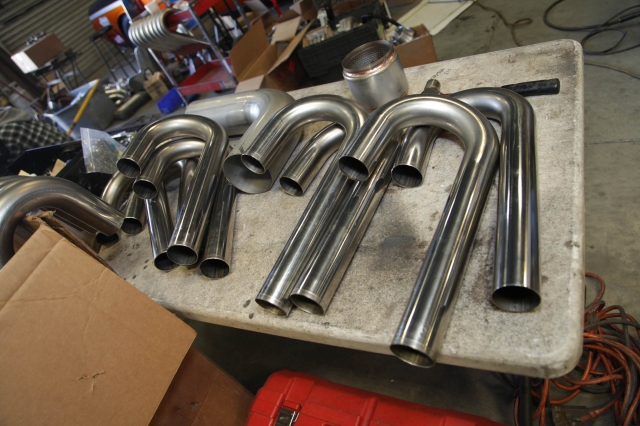
Here are the j-bends that kooks supplied us with to build our headers from. Kooks bases their header configurations on a number of factors, beginning with both the weight of the vehicle and the typical racing distance. For our supercharged combination that’s dragging 3,200 lbs. down the strip, a rather large 2-1/8″ to 2-1/4″ to four-inch setup was decided upon.
“With an 1/8-mile car, you’re going to want as much torque as possible, because you’re running half the distance. Then, we want to figure out the right header with the right step dimensions for your exact engine combination. What comes into play is camshaft duration, lobe separation — the camshaft is big — cylinder heads, how big of a port the cylinder heads have. It may be a tiny motor, but have these huge exhaust ports, so we have to put a big tube on it just to cover the port.”
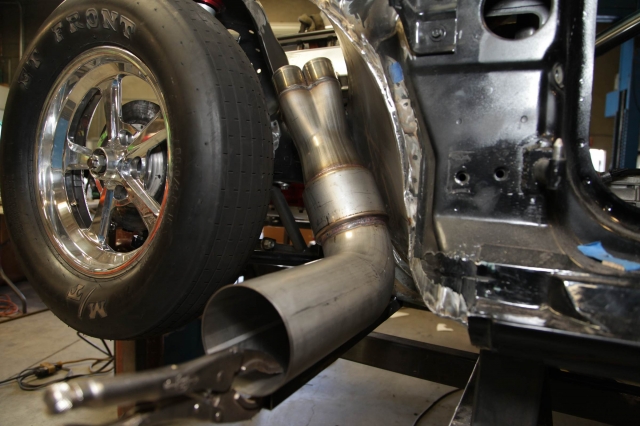
Here you can see the merge and collector mocked up in place, providing a starting point for the construction of the header tubes.
George Kook Jr., the second-generation leader of Kooks and an expert himself in building and matching a set of headers to a combination, further explained, telling us that header sizes and and lengths are determined largely by the engine and vehicle combination. A 3,200 lb. doorslammer, Kook shares, will generally run a smaller diameter primary tube than something like a 1,700 lb. dragster, because you want to gain maximum acceleration with the heavier weight to gain in the sixty-foot department.
“In drag racing, we want to figure out how to make the most peak horsepower and torque throughout the highest part of the RPM range,” says Clark in agreement. “When we’re focusing on that, we generally make a little larger of a tube than if we were looking at the median RPM range.
Kook uses a pair of contrasting engines as examples, pointing out that a 500-inch big block making 800 horsepower at 7,500 rpm will use a 2-1/8 x 2-1/4 x 4-inch header or a 2-3/8 x 4.5-inch merge on nitrous, while a smaller 358-inch small block cranking out 9,500 rpm will be matched to the camshaft, the intake manifold, and valve size, typically settling on a 2 x 2-1/8 x 3 or 3.5-inch merge, and one size larger (2-1/8 x 2-1/4 x 4-inch with no merge or 1-7/8 x 2-1/8 Tri-Y with a 2-3/8-inch secondary into a 3-1/4 or 3.5-inch merge) if nitrous oxide is being used.
Here's a detail shot of the exhaust port and the header tube with the supplied flange mounted up for mocking purposes.
Said Kook, “Merge collectors and Tri-Y headers are used to maximize intake and exhaust scavenging, but they’re not an end-all, be-all. They’re used to broaden a desired RPM range, and if not designed or paired correctly can hinder the the positive results. In some cases, it’s not optimal to run a Tri-Y or a merge because it can starve the exhaust tract and lean out the intake tract (the low pressure point).”
The J-bends are cut into several pieces, using portions of the 180-degree bend and the straight to form the desired header shape. These headers, left and right, were fabricated in just one day at PMR Race Cars.
“Exhaust works the best when it has a constant contained temperature in the pulses and is evacuated in the most efficient way,” Kook went on tell us. “Bullhorns in particular are designed to utilize the exhaust pressure as downforce on the nose of the car, creating as much as 400 pounds of effective downforce. This can be a asset or a hindrance, depending on the car and chassis combination. Funny Cars, with their low, downturned pipes, have been using it to their advantage for years.”
Building BlownZ’s Headers And Bullhorns
We’ve worked with Late Model Engines this off season to help us build a new 400 cubic inch LSX bullet for 2014, and based on their in-house engine development experience and dyno testing, the LME team supplied specific header information to Kooks to supply us with the pieces needed to build the headers.
Puttin' A Muzzle On It
Per the requirements of the 275 Drag Radial class, we have to run a set of mufflers on BlownZ in competition. But the race-specific mufflers out there today are like what you’d find on your daily driver or those used on street legal racing machines years ago. Aside from adding five inches to the overall exhaust length, these pieces from Vibrant Performance go virtually unnoticed. Made of T304 stainless steel, these particular mufflers have a 4.5-inch inlet/outlet and measure five inches in length for tight-fitting race applications (there’s also a 9-inch version in varying diameters), and thanks to a straight-through design, little if any of that valuable horsepower we have from LME is lost by putting them on the car. The result is a quieter (and legal) race car.
Everything was taken into account, from intake runner length and diameter, the lift and lobe separation from the COMP camshaft, the bore and stroke from the Callies crankshaft, GRP rods, and Diamond Pistons, and many other variables to determine a primary header tube diameter of 2-1/8-inches to 2-1/4 to a 4-inch merge and 4.5-inch bullhorn.
“It’s a giant set of headers,”remarked Clark. “As we learned more and got a better idea of the kind of boost planning to be produced, we knew these headers would give the engine plenty of room to breathe.”
Continued Clark, “The biggest thing is that you don’t want to have too big of a header primary, because then you’re going to have scavenging problems.” This is the point at which air is lost out of the engine faster than it can pull air in on overlap, and is something all builders of competitive engines must contend with in sizing headers.
Kooks provided us with a set of standard J-bends, which give a full 180-degree bend so that they can be cut and fit at any angle to shape the tubes as needed. The bends and straight sections of the J-bends are pieced together in what can be best described as an intricate puzzle. Greg at REF Holman fabricated the custom headers, using the location of the collector/bullhorn exist location as the starting point. As we described earlier, this location can differ car to car, and because you already have one of your starting points — the exhaust port on the cylinder heads — determining where the collector will exit provides the other half of the equation.
From there, it’s a matter of angling the pipes around the surrounding components, including the wheel and tire, the steering shaft, and any turbo/blower piping you may have. And as PMR’s Tony Mandella shared with us, although there’s no exact science to how the pipes are routed, the quicker you can get the exhaust out, the better. As well, there’s a general train of thought that each bank should have an equal be length to the same bank on the opposite side of the motor, even if they aren’t shaped/routed identically.
Here's a look at the meticulously-crafted final result after we got the car back from PMR Race Cars. Kooks provides plenty of extra pipe in the bullhorns so the racer can cut them down to size, and we'll be taking a considerable amount off before the car hits the track.
What The Racers Have To Say
For the racers who have adopted them, like Kooks customers Chris Rini and Mike Murillo, bullhorns represent a variable that was long overlooked by the drag racing industry, and one that have played a role in the performance of today’s all-out racing machines.
“Nobody looked at that area for years,” says Pro Mod racer and former NMCA Pro Street champ Chris Rini. “For the longest time, no one even thought about why a blower car with zoomies would run a completely different weight percentage than a nitrous car. But the reason was, they had four tubes on each side pointing up. Sure, we were all running wheelie bars, but you can’t rely on those to drive the car at 300 feet — they’re just a guide to keep you under control in the first sixty feet.”
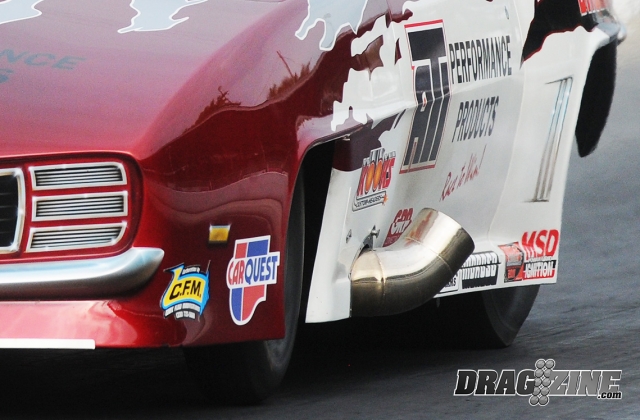
Pro Modified racer Chris Rini firmly believes in the advantages of bullhorns, having tested them side-by-side with their previous exhaust setups and noting a difference in how the car reacts in the front half of the track.
Murillo, a many-time champion driver in the street car ranks, was one of the first racers to move to the bullhorns on his SCT Performance Outlaw 10.5 Mustang, and he insists his team saw the benefits right out of the gate.
“We couldn’t even get down our local track before we moved to the bullhorns, and after we put them on, we went straight down three passes in a row and made a career best run to that point,” Murillo said.
“It was like we had a completely different car, and it was all for the better” said Murillo, who runs a 4-inch bullhorn on his car. “We didn’t hit the wheelie bars as hard, which meant we were able to leave a little harder. It had a snowball effect in that we were able to change several things around — it really helps with your weight transfer.”
Initially, my thought was the bullhorns were just to keep the front end down, but inevitably, it helped with the entire car.” Murillo told us. “It creates downforce both front and rear. – Mike Murillo
Rini and his ATI Performance Products team consider the addition of the bullhorns to their big-inch Camaro as a definitive advantage for their program, and one they’ve gone to great lengths to understand and implement. “We’ve done back-to-back testing with the straight-out style of headers that we used to run and with the bullhorns, and we could tell a real difference in how the nose lifts and how the car performs early in the run. It’s been a noticeable gain, and is another element we can use to tune the chassis to make it more manageable and produce more repeatable runs.”
“Obviously, cars are fastest when they’re going forward and not up, and the more you can control that, the better the car is going to run,” explains Rini.
“Initially, my thought was the bullhorns were just to keep the front end down, but inevitably, it helped with the entire car.” Murillo told us. “It creates downforce both front and rear. It’s hard to measure it, but we’ve seen it with Top Fuel Dragsters and the way they react when they drop a cylinder for years, so there’s obviously something to it.”
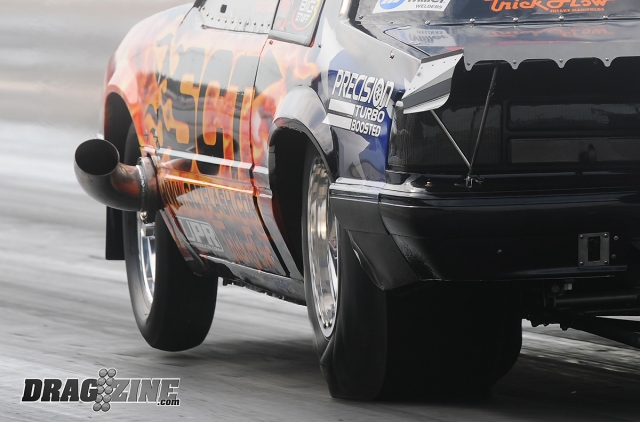
Mike Murillo was one of the earliest adopters of bullhorns, and his SCT Performance team saw a significant difference in the handling and performance of their 10.5W-tire Mustang right out of the box.
Along with collector/bullhorn diameters — which play into the “thrust” the exhaust produces and therefore its theoretical downforce — both Murillo and Rini have experimented with bullhorn angles, and both indicate there are tuning advantages based on the chassis setup and the race track in doing so. In fact, Murillo’s team has degree markings on the piping on his Mustang and will clock the bullhorn depending on track conditions, at angles ranging from 35 to 50 degrees. What it all adds up to is an advantage that plays into the racers’ hand, and one they can easily tune, as well.
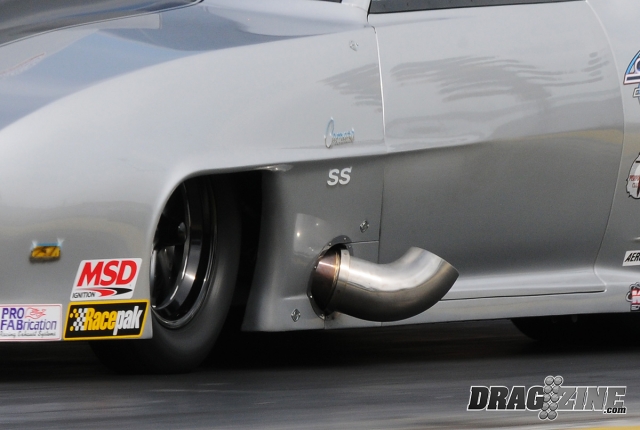 Says Rini in closing, “I think the bullhorns coming to the industry was an overlooked area for a long time, and now it’s become an area that most people that are serious about performance are looking at, because with these engines, whether they’re nitrous assisted, blown, or turbocharged, they’re passing a lot of air at a high rate of speed, and it produces a lot of pressure. It’s not static weight. They’re more of a mainstay now than ever before because people have seen the performance gain they provide and the benefits.”
Says Rini in closing, “I think the bullhorns coming to the industry was an overlooked area for a long time, and now it’s become an area that most people that are serious about performance are looking at, because with these engines, whether they’re nitrous assisted, blown, or turbocharged, they’re passing a lot of air at a high rate of speed, and it produces a lot of pressure. It’s not static weight. They’re more of a mainstay now than ever before because people have seen the performance gain they provide and the benefits.”
“There’s nothing scientific to put behind it, all you can really say is, ‘trust me, it works,’” says Murillo.
Bullhorns, like many things in the high performance world, are an example of function over form, and regardless of how they look, enough evidence exists through on-track testing that they do indeed provide advantages to those who use them in specific vehicle and engine applications. For most racers, that’s all they need to know, and within this text, you’ve heard the confirmation straight from the source. Just trust them, it works.



